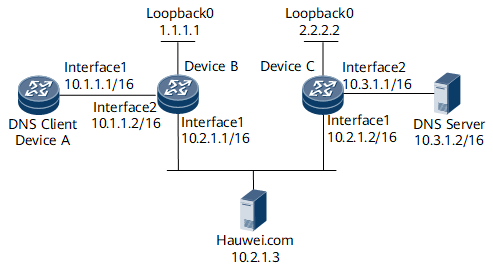Example for Configuring Dynamic DNS Client
This section describes how to configure dynamic DNS.
Networking Requirements
As shown in Figure 1, Device A serves as the DNS client. With the help of the DNS server, Device A can use the domain name "huawei.com" to access the host with IP address 10.2.1.3/16.
Configuration Roadmap
The configuration roadmap is as follows:
Enable dynamic DNS.
Configure the IP address of the DNS server.
Configure a domain name suffix.
Data Preparation
To complete the configuration, you need the following data:
Domain names of Device B and Device C
IP address of the DNS server
Domain name suffixes
Procedure
- Configure Device A.
# Configure dynamic DNS entries.
<HUAWEI> system-view [~HUAWEI]sysname DeviceA [*HUAWEI]commit
# Enable dynamic DNS.
[~DeviceA] dns resolve
# Configure the IP address of the DNS server.
[*DeviceA] dns server 10.3.1.2
# Configure a domain name suffix "net".
[*DeviceA] dns domain net
# Configure a domain name suffix "com".
[*DeviceA] dns domain com [*DeviceA] commit [~DeviceA] quit

To implement domain name resolution, you must configure a route between Device A and the DNS server for them to communicate. For details about how to configure a route, see NetEngine 8000 FRouter Configuration Guide - IP Routing.
- Verify the configuration.
# Run the ping huawei command on Device A. The host with domain name "huawei.com" can be pinged. The destination IP address for the ping operation is 10.2.1.3.
<DeviceA> ping huawei.com PING huawei.com (10.2.1.3): 56 data bytes, press CTRL_C to break Reply from 10.2.1.3: bytes=56 Sequence=1 ttl=126 time=6 ms Reply from 10.2.1.3: bytes=56 Sequence=2 ttl=126 time=4 ms Reply from 10.2.1.3: bytes=56 Sequence=3 ttl=126 time=4 ms Reply from 10.2.1.3: bytes=56 Sequence=4 ttl=126 time=4 ms Reply from 10.2.1.3: bytes=56 Sequence=5 ttl=126 time=4 ms --- huawei.com ping statistics --- 5 packet(s) transmitted 5 packet(s) received 0.00% packet loss round-trip min/avg/max = 4/4/6 ms# Run the display dns dynamic-host command on Device A. Dynamic DNS entry information stored in the cache is displayed.
<DeviceA> display dns dynamic-host No Domain Name IpAddress TTL Alias 1 huawei.com 10.2.1.3 3579
TTL indicates how long a DNS entry can exist, in seconds.
Configuration Files
Configuration file of Device A
# sysname DeviceA # dns resolve dns server 10.3.1.2 dns domain net dns domain com # interface GigabitEthernet0/1/0 undo shutdown ip address 1.1.1.2 255.255.0.0 # rip 1 network 1.0.0.0 # return
Configuration file of Device B
# sysname DeviceB # interface GigabitEthernet0/1/0 undo shutdown ip address 2.1.1.1 255.255.0.0 # interface GigabitEthernet0/1/1 undo shutdown ip address 1.1.1.1 255.255.0.0 # interface LoopBack0 ip address 4.1.1.1 255.255.255.255 # rip 1 network 2.0.0.0 network 1.0.0.0 network 4.0.0.0 # return
Configuration file of Device C
# sysname DeviceC # interface GigabitEthernet0/1/0 undo shutdown ip address 2.1.1.2 255.255.0.0 # interface GigabitEthernet0/1/1 undo shutdown ip address 3.1.1.1 255.255.0.0 # interface LoopBack0 ip address 4.1.1.2 255.255.255.255 # rip 1 network 2.0.0.0 network 3.0.0.0 network 4.0.0.0 # return
